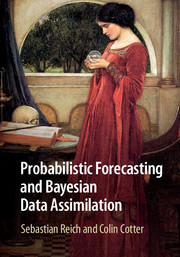Refine search
Actions for selected content:
2567 results in Computational Science
7 - McKean approach to data assimilation
- from Part II - Bayesian Data Assimilation
-
- Book:
- Probabilistic Forecasting and Bayesian Data Assimilation
- Published online:
- 05 May 2015
- Print publication:
- 14 May 2015, pp 200-228
-
- Chapter
- Export citation
4 - Stochastic processes
- from Part I - Quantifying Uncertainty
-
- Book:
- Probabilistic Forecasting and Bayesian Data Assimilation
- Published online:
- 05 May 2015
- Print publication:
- 14 May 2015, pp 96-130
-
- Chapter
- Export citation
Part II - Bayesian Data Assimilation
-
- Book:
- Probabilistic Forecasting and Bayesian Data Assimilation
- Published online:
- 05 May 2015
- Print publication:
- 14 May 2015, pp 169-170
-
- Chapter
- Export citation
2 - Introduction to probability
- from Part I - Quantifying Uncertainty
-
- Book:
- Probabilistic Forecasting and Bayesian Data Assimilation
- Published online:
- 05 May 2015
- Print publication:
- 14 May 2015, pp 33-64
-
- Chapter
- Export citation
References
-
- Book:
- Probabilistic Forecasting and Bayesian Data Assimilation
- Published online:
- 05 May 2015
- Print publication:
- 14 May 2015, pp 289-294
-
- Chapter
- Export citation
3 - Computational statistics
- from Part I - Quantifying Uncertainty
-
- Book:
- Probabilistic Forecasting and Bayesian Data Assimilation
- Published online:
- 05 May 2015
- Print publication:
- 14 May 2015, pp 65-95
-
- Chapter
- Export citation

Probabilistic Forecasting and Bayesian Data Assimilation
-
- Published online:
- 05 May 2015
- Print publication:
- 14 May 2015
Bespoke finite difference schemes that preserve multiple conservation laws
- Part of
-
- Journal:
- LMS Journal of Computation and Mathematics / Volume 18 / Issue 1 / 2015
- Published online by Cambridge University Press:
- 01 May 2015, pp. 372-403
-
- Article
-
- You have access
- Export citation
Nilpotent-independent sets and estimation in matrix algebras
- Part of
-
- Journal:
- LMS Journal of Computation and Mathematics / Volume 18 / Issue 1 / 2015
- Published online by Cambridge University Press:
- 01 May 2015, pp. 404-418
-
- Article
-
- You have access
- Export citation
Coleman integration for even-degree models of hyperelliptic curves
- Part of
-
- Journal:
- LMS Journal of Computation and Mathematics / Volume 18 / Issue 1 / 2015
- Published online by Cambridge University Press:
- 01 April 2015, pp. 258-265
-
- Article
-
- You have access
- Export citation
On the distribution of Atkin and Elkies primes for reductions of elliptic curves on average
- Part of
-
- Journal:
- LMS Journal of Computation and Mathematics / Volume 18 / Issue 1 / 2015
- Published online by Cambridge University Press:
- 01 April 2015, pp. 308-322
-
- Article
-
- You have access
- Export citation
Champ: a Cherednik algebra Magma package
- Part of
-
- Journal:
- LMS Journal of Computation and Mathematics / Volume 18 / Issue 1 / 2015
- Published online by Cambridge University Press:
- 01 April 2015, pp. 266-307
-
- Article
-
- You have access
- Export citation
The maximal subgroups of
 $E_{7}(2)$
$E_{7}(2)$
- Part of
-
- Journal:
- LMS Journal of Computation and Mathematics / Volume 18 / Issue 1 / 2015
- Published online by Cambridge University Press:
- 01 April 2015, pp. 323-371
-
- Article
-
- You have access
- Export citation
Piecewise Legendre spectral-collocation method for Volterra integro-differential equations
- Part of
-
- Journal:
- LMS Journal of Computation and Mathematics / Volume 18 / Issue 1 / 2015
- Published online by Cambridge University Press:
- 01 April 2015, pp. 231-249
-
- Article
-
- You have access
- Export citation
Computing overconvergent forms for small primes
- Part of
-
- Journal:
- LMS Journal of Computation and Mathematics / Volume 18 / Issue 1 / 2015
- Published online by Cambridge University Press:
- 01 April 2015, pp. 250-257
-
- Article
-
- You have access
- Export citation
Construction of spline curves on smooth manifolds by action of Lie groups
- Part of
-
- Journal:
- LMS Journal of Computation and Mathematics / Volume 18 / Issue 1 / 2015
- Published online by Cambridge University Press:
- 01 February 2015, pp. 217-230
-
- Article
-
- You have access
- Export citation
Computing separable isogenies in quasi-optimal time
- Part of
-
- Journal:
- LMS Journal of Computation and Mathematics / Volume 18 / Issue 1 / 2015
- Published online by Cambridge University Press:
- 01 February 2015, pp. 198-216
-
- Article
-
- You have access
- Export citation
Genus-2 curves and Jacobians with a given number of points
- Part of
-
- Journal:
- LMS Journal of Computation and Mathematics / Volume 18 / Issue 1 / 2015
- Published online by Cambridge University Press:
- 01 February 2015, pp. 170-197
-
- Article
-
- You have access
- Export citation
McCammond’s normal forms for free aperiodic semigroups revisited
- Part of
-
- Journal:
- LMS Journal of Computation and Mathematics / Volume 18 / Issue 1 / 2015
- Published online by Cambridge University Press:
- 01 January 2015, pp. 130-147
-
- Article
-
- You have access
- Export citation
Finite basis problem for semigroups of order six
- Part of
-
- Journal:
- LMS Journal of Computation and Mathematics / Volume 18 / Issue 1 / 2015
- Published online by Cambridge University Press:
- 01 January 2015, pp. 1-129
-
- Article
-
- You have access
- Export citation





































































